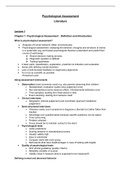Samenvatting
Summary Psychological Assessment
- Instelling
- Tilburg University (UVT)
This document entails a summary of the mandatory reading material for the 3rd year Bachelor course Psychological Assessment. Especially all the chapters from the book "Psychological Communication: Theories, Skills and Roles for Counsellors" are included.
[Meer zien]






